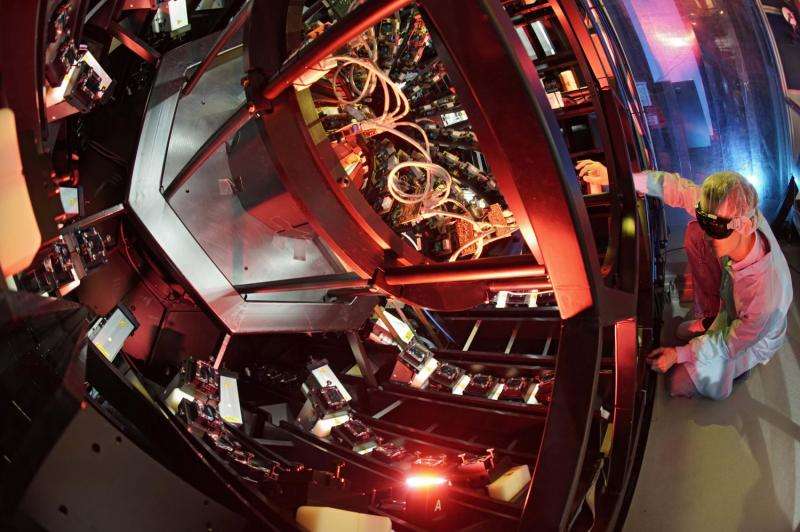Jena laser system sets another world record

POLARIS is the world's most powerful fully diode-pumped laser system, which produces the world's highest-performing laser pulses. A team of physicists under the leadership of Prof. Dr Malte Kaluza at the Institute of Optics and Quantum Electronics has now improved POLARIS' performance significantly. For the first time, the laser has produced pulses delivering an energy of more than 50 Joules, which is more than three times as high as before.
50 Joules is the amount of energy needed to lift an object weighing 500 g approximately 10 m off the ground; to raise the temperature of a glass of water by only one degree, however, 17 times as much energy is required. For a high-performance laser system like POLARIS, 50 Joules therefore seems rather meagre. "But our laser system delivers this amount of energy in a very short time interval," explains Prof. Kaluza. The laser pulses have a duration of 120 femtoseconds. In this unimaginably brief moment—a femtosecond is one thousand-million-millionth of a second—the laser reaches a peak power of several hundred terawatts (TW). This is many times higher than all the electrical power produced worldwide.
This increase in the laser system's performance is the result of several months of development. "The basic architecture and set-up of the laser have not changed," says Prof. Kaluza, "but we succeeded in changing and improving many small details decisively."
The last and largest power amplifier of POLARIS now uses ytterbium-doped calcium fluoride crystals. And the optical coating of the materials put under enormous stress by the laser radiation has been further optimized. "All these small changes together now allow us to reach a considerably higher laser energy than before," explains Kaluza. But the laser physicist also suggests that the 54.16 Joules now achieved is only the beginning.
As the next stage of development, Kaluza, who also is the holder of the chair of experimental physics and relativistic laser physics, now plans to shorten the duration of pulses in the POLARIS system even further, reducing the duration to no more than 100 femtoseconds. The steady reduction of the duration is, however, not a goal in itself. "We are not looking to always set new records," explains Kaluza. On the contrary, the objective is to adapt POLARIS for specific uses. First and foremost, the laser is meant to be used as a tool for particle acceleration. "We have already conducted some first experiments in this field with lower pulse energy and longer laser pulses. Now we are excited to see how the particle energy will scale with the much higher laser energy and concurring shorter pulse duration."
Intense and highly energetic ion radiation can, for example, be used in tumour treatment. So far, the generation of these highly energetic particles required tremendous technical efforts in very large particle accelerators. "With the amount of energy we are now able to generate, we can offer laser systems like POLARIS for particle irradiation, which are comparatively 'easy to handle' and manageable. We are now curious to see to what particle energy we can now make it with the new laser pulses," says Prof. Kaluza.
More information: More information at: www.hi-jena.de/en/helmholtz_in … ities/local/polaris/
Provided by Friedrich Schiller University of Jena




















